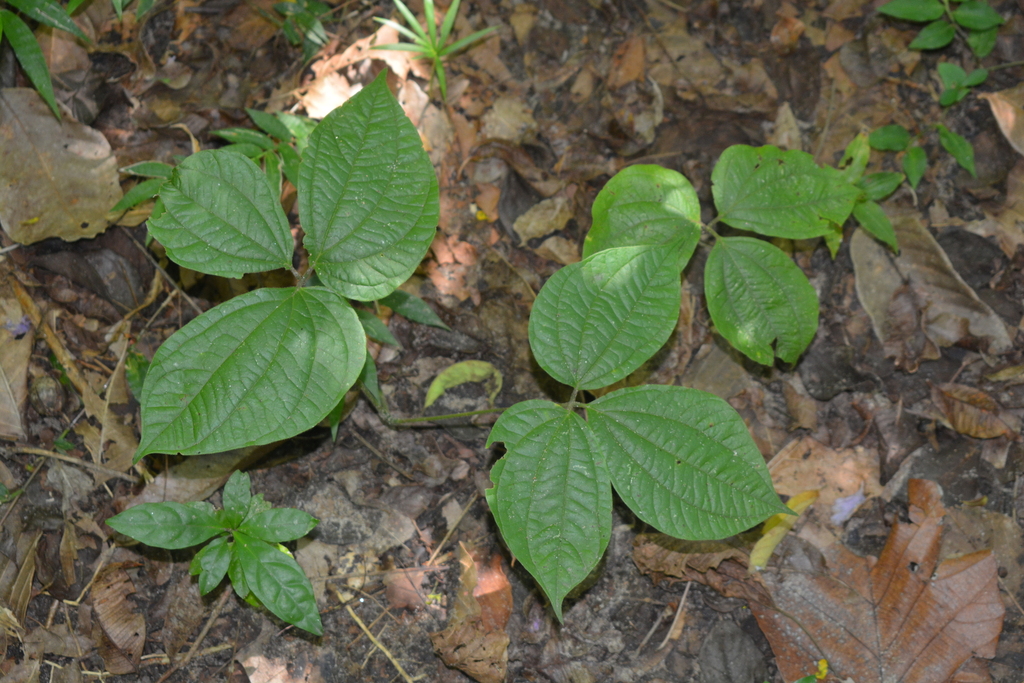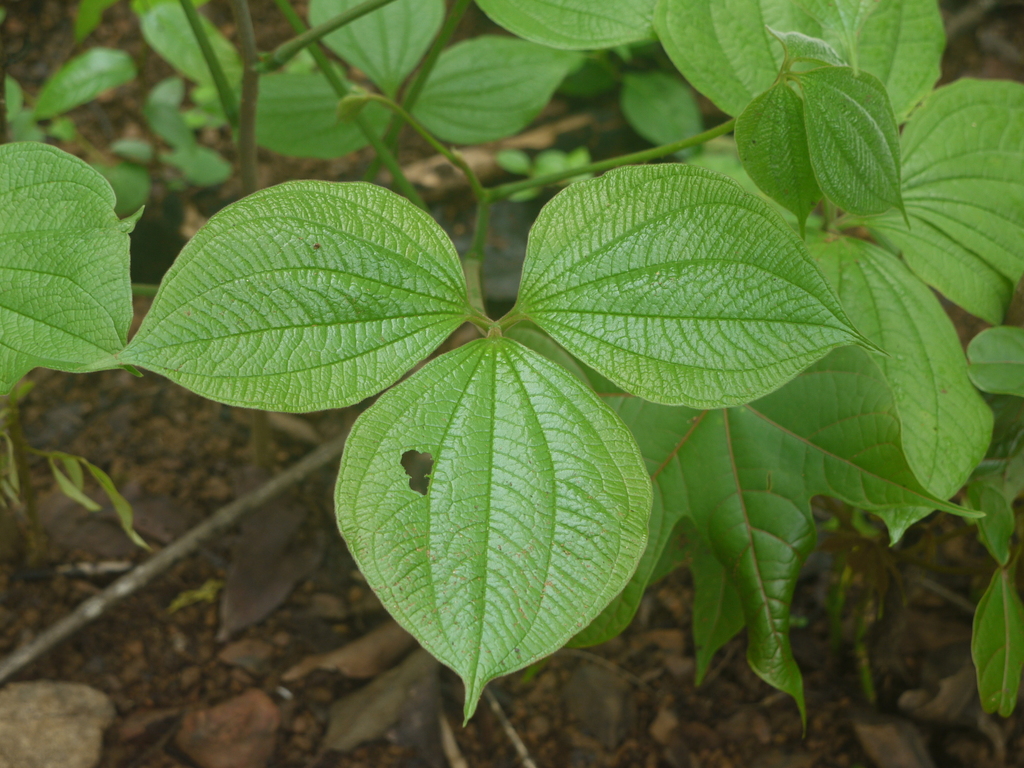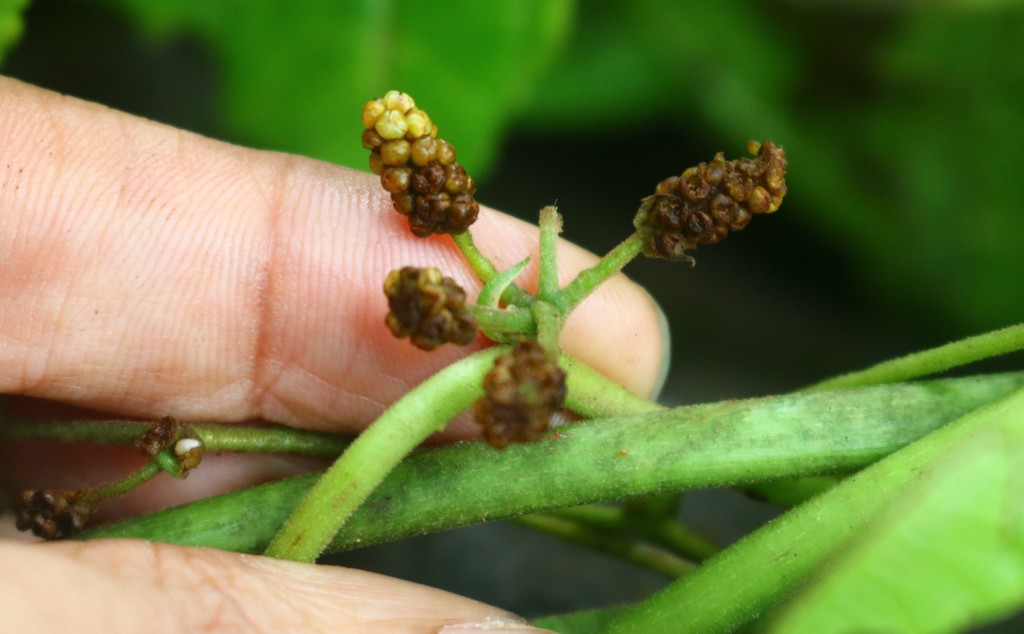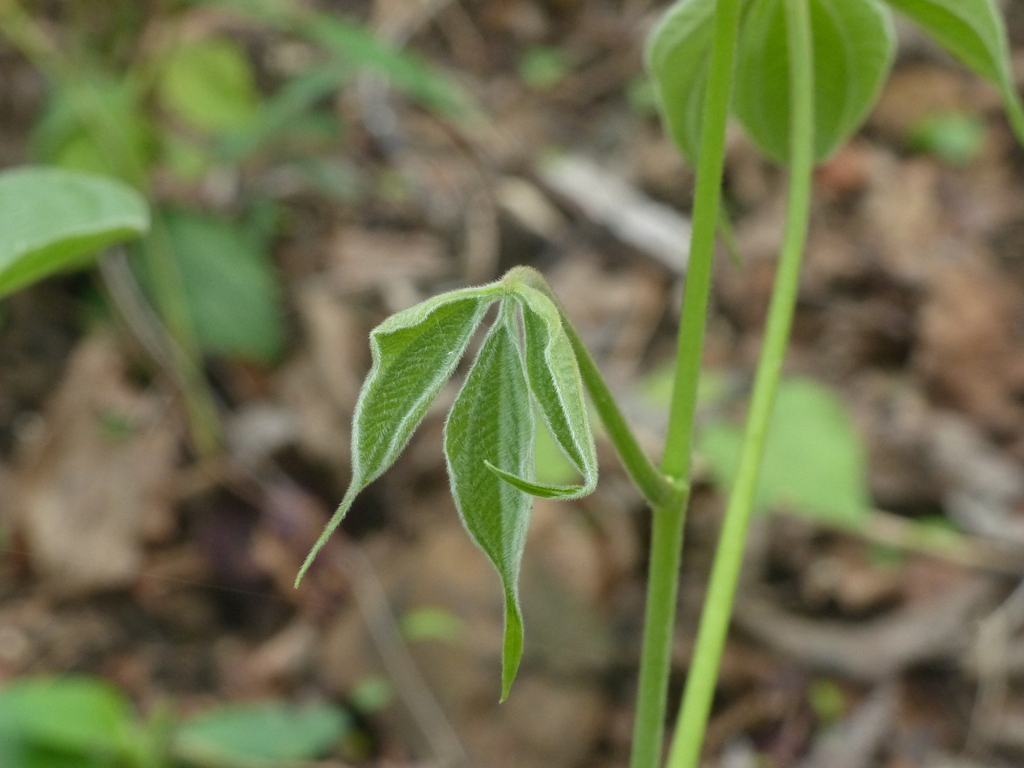ລະດັບການຮວບຮວມຂໍ້ມູນ: ຂໍ້ມູນພື້ນຖານ
ຫົວກອຍ
Asiatic Bitter Yam
Dioscorea hispida Dennst.
ພືດ
ພືດລົ້ມລຸກ
ຜັກ ແລະ ພືດລົ້ມລຸກ
1 / 4

2 / 4

3 / 4

4 / 4

❮
❯
ຊື່ທ້ອງຖີ່ນ:
ໄທ: ມັນກອຍ, ມັນກລອຍ, ລາບຊາບ, ມັນນອນ, ກລອຍເຂົາໂຈ, ກລອຍນົກ, ກລອຍໄກ່, ຄລີ(ເນື້ອຂາວ), ຄລອຍເຂົ້າໜຽວ (ເນື້ອເຫຼືອງ).
ກໍາປູເຈຍ: ດູເຄົາ, ເວີເຄົາ.
ມຽນມ້າ: ກີວິ.
ຫວຽດນາມ: ກູຍ ນັນ, ເທລນອັນເອັດ, ດິວນານອິນ.
ອັງກິດ: Asiatic bitter yam. ( ກອຍ, ເຄື່ອກອຍ
Local names: koi, kheua koi
Thai: man koi, man kloi, llah sah, man non, kloi khao chow, kloi nok,
kloi kai, khli (white flesh), khoi khao nio, kloi hua nio (yellow flesh).
Cambodian: do khouch, voeur khouch
Burmese: kywe
Vietnamese: cu nan, train an et, diau nan in
English: Asiatic bitter yam)
ຊື່ພ້ອງ
:
Dioscorea hispida var. daemona (Roxb.) Prain & Burkill
Dioscorea hispida var. reticulata (Hook.f.) Sanjappa
Helmia daemona (Roxb.) Kunth
Helmia hirsuta (Blume) Kunth
ບັນຍາຍລັກສະນະທາງພືດສາດ:
ເປັນພືດເຄືອ ຍາວປະມານ 2 ມ, ທີ່ກ້ຽວໄປທາງຊ້າຍມື, ມີໜາມແຂງ ແລະ ມີລະບົບຮາກຝອຍ ໂດຍຈຳນວນຫນຶ່ງ ໃນນັ້ນໄດ້ເຕີບໂຕຂຶ້ນເປັນຫົວມົນນ້ອຍໆ ເວລາຍັງອ່ອນແລ້ວຍາວຢຽດອອກເວລາຫົວແກ່ຂຶ້ນ ແຕ່ກໍ່ຍັງຄົງຮູບຮ່າງລັກສະນະຂ້ອນຂ້າງມົນເໝືອນເດີມ ແລະ ສາມາດເຕີບໂຕເຖິງຂະໜາດໜ້າຕັດ ປະມານ 30 ຊມ ແລະ ມີນ້ຳໜັກ ປະມານ 35 ກລ. ຫົວກອຍ ມີສີນ້ຳຕານ ແລະ ມີຮາກຝອຍເສັ້ນນ້ອຍໆສີເຟືອງຫາສີຫມົ່ນອ່ອນໆຈັບຕາມຜິວດ້ານນອກ. ຫົວກອຍດິບທີ່ບັນຈຸມີທາດເບື່ອ ມີເນື້ອຂ້າງໃນເປັນສີຂາວຫາສີເຫຼືອງອ່ອນໆ. ເຄືອມີຂະໜາດໜ້າຕັດປະມານ 9 ມມ, ມີໜາມ ແລະ ມີສີຂຽວຫາສີເຟືອງ. ໃບມີຂະໜາດ 30 x 28 ຊມ ປະກອບດ້ວຍ 3 ໃບນ້ອຍມີໜາມອ່ອນຕາມກ້ານໃບ ແລະ ເຊັ່ນໃບດ້ານຫຼັງ ພ້ອມມີຂົນຕາມກ້ອງໃບ. ພົ້ວດອກຜູ້ ຍາວປະມານ 50 ຊມ ກົ່ງລົງທາງລຸ່ມ ມີດອກສີເຫຼືອງ ຫາ ສີນ້ຳຕານອ່ອນ, ຫຸ້ມດ້ວຍຂົນອ່ອນໆສີຂາວສຳລັບພົ້ວດອກແມ່ ເປັນດອກດ່ຽວ. ໝາກເປັນໝາກແຄັບຊູນ (capsule) ສີນ້ຳເຜີ້ງ, ມີປີກ, ມີຂະໜາດປະມານ 40-60 x 10-12 ມມ ແລະ ແກ່ນ ກໍ່ມີປີກຄືກັນ. ໃນອິນດູຈີນ ພົບວ່າ ມີທັງໝົດ 4 ສາຍພັນ ຂອງກອຍ ເຊັ່ນ: ສາຍພັນ mollissima, scaphoides, hispida ແລະ dalmona. ໃນເຂດອິນດູຈີນມີປະມານ 12-15 ຊະນິດມັນ ທີ່ເກີດໃນທຳມະຊາດ ແລະ ໃນນີ້ ̧ມີ Dioscorea alata L. (ມັນທຽນຂາວ) ແລະ D. bulbifera L. (ມັນເປົ້າ) ທີ່ໄດ້ນຳມາປູກເປັນພືດສວນ.
ເຂດກະຈາຍພັນໃນລາວ
:
ເຂດສາຍພູຫຼວງພາກເໜືອ
ເຂດກະຈາຍພັນຕາມພູມສັນຖານ
:
ສະຖານະພາບການອະນູຮັກ IUCN
:
N/A
ສະຖານະພາບການອະນຸຮັກແຫ່ງຊາດລາວ
:
N/A
ປະເພດການນຳໃຊ້:
ອາຫານ
ພືດເປັນຢາ
ບັນຍາຍການນຳໃຊ້:
ຫົວກອຍ ໄດ້ນຳໃຊ້ເປັນອາຫານທົດແທນເຂົ້າ ໃນຊ່ວງທີ່ອຶດເຂົ້າ. ເຖິງຢ່າງໃດກໍ່ດີ, ກ່ອນຈະບໍລິໂພກໄດ້ ກໍໍ່ຕ້ອງໄດ້ກຳຈັດສານເບື່ອອອກກ່ອນ ເພາະກອຍດິບ ປ່ຽງຂະໜາດເທົ່າກັບໝາກແອັບເປິນ ສາມາດທຳລາຍລະບົບປະສາດສ່ວນກາງໄດ້ ແລະ ມີປະສິດທິພາບພໍທີ່ຈະຂ້າຊີວິດຄົນເຮົາໄດ້ ພາຍໃນ 6 ຊົ່ວໂມງ. ກອຍໄດ້ຖືກໃຊ້ເຮັດຂອງຫວານກິນກັບເຂົ້າໜຽວ ແລະ ກໍ໋ຍັງມີສັບພະຄຸນຫຼາຍຢ່າງ ສຳລັບການປຸງແຕ່ງເປັນຢາປົວພະຍາດ. ມັນມັກຖືກນຳໃຊ້ເຂົ້າໃນການປິ່ນປົວບາດແຜຕາມຜິວໜັງ ຫຼື ອາການຄັນ ແລະ ເຈັບປວດຕາມຂໍ້. ຢູ່ໃນເທດໄທ ເພີ່ນນຳໃຊ້ກອຍຝານບາງໆເພື່ອລົດຜ່ອນອາການກ້າມເນື້ອທ້ອງປົນ ແລະ ທຳຄວາມສະອາດບາດແຜ. ສານພິດຂອງກອຍ ຖືກໃຊ້ເປັນສານທາຫົວຫອກ ແລະ ເບ່ື່ອປາ. ຢູ່ປະເທດອິນເດຍ ເພີ່ນໄດ້ນຳໃຊ້ສຳລັບເບື່ອເສືອ ດ້ວຍການເອົາໄປເຊື່ອງຊ້ອນໄວ້ໃນຊາກສັດທີ່ເສືອກິນ. ທີ່ມາເລເຊຍ ກອຍໄດ້ຖືກນຳໃຊ້ເປັນຢາຕ້ານເຊື້ອ ແລະ ນອກຈາກນັ້ນ, ກອຍກໍ່ຍັງມີ ຄຸນສົມບັດໃນການປ້ອງກັນບົ້ງແມງອີກດ້ວຍ.
ການຕະຫຼາດ ແລະ ຕ່ອງໂສ້ມູນຄ່າ:
N/A
ບັນຍາຍຄຸນຄ່າທາງໂພຊະນາການ:
N/A
| ສານອາຫານ |
/100g |
ໝາຍເຫດ |
| ໂປຣຕີນ |
N/A |
N/A |
| ຄາໂບໄຮເດຣດ |
N/A |
N/A |
| ໄຂມັນ |
N/A |
N/A |
| ວິຕາມິນ |
N/A |
N/A |
| ແຮ່ທາດ |
N/A |
N/A |
| ເສັ້ນໄຍ |
N/A |
N/A |
ອ້າງອິງ:
NUoL; NAFRI; SNV. 2007. Non-timber forest products in the Lao PDR : a manual of 100 commercial and traditional produce.
National Agriculture and Forestry Research Institute.
Burkill, I.H., 1951. Dioscoreaceae. Dioscorea hispida. In: van Steenis, C.G.G.J. (Editor): Flora Malesiana. Series 1. Vol. 4. Noordhoff-Kolff, Djakarta, Indonesia. pp. 318-320.
Rao, P.S. & Beri, R.M., 1952. Tubers of Dioscorea hispida Dennst. The Indian Forester 78(3): 146-152.
Onwueme, I.C., 1978. The tropical tuber crops. Wiley, Chichester, United Kingdom. pp. 3-106.
Wilkin, P. & Thapyai, C. (2009). Flora of Thailand 10(1): 1-140. The Forest Herbarium, National Park, Wildlife and Plant Conservation Department, Bangkok.




